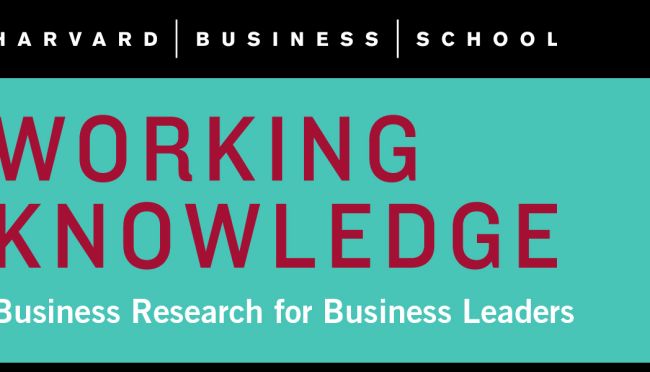Wages →
→

- 07 Feb 2023
- Research & Ideas
Supervisor of Sandwiches? More Companies Inflate Titles to Avoid Extra Pay
What does an assistant manager of bingo actually manage? Increasingly, companies are falsely classifying hourly workers as managers to avoid paying an estimated $4 billion a year in overtime, says research by Lauren Cohen.

- 15 Oct 2020
- Research & Ideas
IT Job Wages Are No Longer 'Exceptional'
Wage growth in IT jobs has moderated following the dot-com boom, according to new research by Ruiqing Sam Cao and Shane Greenstein. Open for comment; 0 Comments.

- 14 Sep 2020
- Working Paper Summaries
Digital Labor Market Inequality and the Decline of IT Exceptionalism
The experience in five cities accounts for almost all the wage inequality in IT wages in the US between 2000 and 2018. Overall that brought IT wages closer to STEM wages.

- 25 Mar 2019
- Research & Ideas
The Secret Life of Supply Chains
While US policymakers and politicians focus on reviving the manufacturing sector, Mercedes Delgado and Karen Mills unearth a source of better jobs hidden in plain sight. Call it the supply chain economy. Open for comment; 0 Comments.

- 29 Apr 2018
- Working Paper Summaries
Analyzing the Aftermath of a Compensation Reduction
This study of the effects of compensation cuts in a large sales organization provides a unique lens for analyzing the link between compensation schemes, worker performance, and turnover.

- 05 May 2017
- Working Paper Summaries
Survival of the Fittest: The Impact of the Minimum Wage on Firm Exit
This study examines the impact of minimum wage increases on restaurant closures in the San Francisco Bay Area, using data from 2008 through 2016 from the review platform Yelp. The study demonstrates that higher minimum wages increase closure rates among lower-rated restaurants, while higher-rated restaurants are largely insulated from changes.

- 21 Dec 2015
- Working Paper Summaries
Wage Elasticities in Working and Volunteering: The Role of Reference Points in a Laboratory Study
Nonprofit organizations often rely on reference points—explicit or implicit targets and goals—to encourage more effort from volunteers. This study finds that effort does tend to cluster around reference levels, so this may be perceived as a very effective strategy. Yet reference levels can potentially backfire: in response to higher volunteer wages or productivity, volunteers may reduce their effort so as to meet the reference level.
- 30 Nov 2015
- Research & Ideas
Donors Are Turned Off by Overhead Costs. Here’s What Charities Can Do
Elizabeth A. Keenan and colleagues find that charitable donors are willing to stomach the idea of overhead costs—as long as they know someone else’s donation is covering them. A field study helped one organization nearly triple its solicited donations. Open for comment; 0 Comments.
- 09 Nov 2015
- Research & Ideas
These Employers Pay Higher Salaries than Necessary
Some employers using online freelance marketplaces for the first time pay more than they have to for workers. Why? An information imbalance that job seekers can exploit, as explained in research by professor Christopher T. Stanton. Open for comment; 0 Comments.
- 10 Aug 2015
- Research & Ideas
Why a Federal Rule on CEO Pay Disclosure May Get You In Trouble With Customers
The SEC is expected to adopt a rule requiring every public firm to disclose the ratio of the CEO's salary to the median salary of the firm's employees. And it turns out that customers prefer shopping from retailers with low pay ratios, according to new research by Bhavya Mohan, Michael Norton, and Rohit Deshpandé. Open for comment; 0 Comments.
- 06 Jul 2015
- Research & Ideas
Money and Quotas Motivate the Sales Force Best
Bonus programs are effective for motivating sales people, but also costly for companies to maintain. Doug Chung and Das Narayandas study several compensation schemes to see which work best. Open for comment; 0 Comments.

- 16 Jun 2015
- Working Paper Summaries
Paying Up for Fair Pay: Consumers Prefer Firms with Lower CEO-to-Worker Pay Ratios
The pay ratio of CEOs to average workers has long been a question of interest to both employees and investors. It also matters to consumers, as shown by new research conducted by the authors of this paper. A firm with a high (1000 to 1) ratio needs to offer a 50 percent discount in order to garner as favorable consumer impressions as a firm with a low (5 to 1) pay ratio. Even if pay ratio disclosure does not become legally mandated, these results suggest that firms with low pay ratios relative to competitors may wish to begin to disclose this information voluntarily. Closed for comment; 0 Comments.

- 04 Feb 2014
- Working Paper Summaries
From Crowds to Collaborators: Initiating Effort and Catalyzing Interactions Among Online Creative Workers
Online "organizations" are becoming a major engine for knowledge development in a variety of domains such as Wikipedia and open source software development. Many online platforms involve collaboration and coordination among members to reach common goals. In this sense, they are collaborative communities. This paper asks: What factors most inspire online teams to begin to collaborate and to do so creatively and effectively? The authors analyze a data set of 260 individuals randomly assigned to 52 teams tasked with developing working solutions to a complex innovation problem over 10 days, with varying cash incentives. Findings showed that although cash incentives stimulated a significant boost of effort per se, cash incentives did not transform the nature of the work process or affect the level of collaboration. In addition, at a basic yet striking level, the likelihood that an individual chooses to participate depended on whether teammates were themselves active. Moreover, communications among teammates led to more communications, and communications among teammates also stimulated greater continuous levels of effort. Overall, the study sheds light on how perspectives on incentives, predominant in economics, and perspectives on social processes and interactions, predominant in research on organizational behavior and teams, can be better understood. Key concepts include: An individual's likelihood of being active in online collaboration increases by about 41 percent with each additional active teammate. Management could provide communications channels to make the efforts of other members more visible. This is important in the design of systems for online work as it helps members to confirm that others are actively contributing. Closed for comment; 0 Comments.
- 29 Oct 2013
- Research & Ideas
Do Employees Work Harder for Higher Pay?
In a recent field study, Duncan Gilchrist, Michael Luca, and Deepak Malhotra set out to answer a basic question: "Do employees work harder when they are paid more?" Closed for comment; 0 Comments.

- 24 Oct 2013
- Working Paper Summaries
When $3+$1 > $4: The Effect of Gift Salience on Employee Effort in an Online Labor Market
Do employees work harder when they are paid more? This study shows that paying above-market wages, per se, does not have an effect on effort. The authors offered an experiment in a field setting that allowed them to test for the conditions under which higher wages elicit higher effort. They hired three groups of workers for a data entry task on the online labor market oDesk.com, telling them all that this was a one-time job. Group one ("3") was hired at $3 per hour. Group two ("3+1") was also hired at $3 per hour, but before starting work, people in group two were told that there was unexpectedly extra money in the budget and they would instead be paid $4 per hour. Group three ("4") was hired directly at $4 per hour, so that the "extra" money would not signal a salient "gift" from the employer. Our findings show that higher wages in which the gift was salient (3+1) led to higher and more persistent effort. However, higher wages by themselves (4) had no effect on effort compared to the lower wage (3) condition. Moreover, higher effort in the 3+1 group was strongest for employees with the most experience on oDesk, and those who had worked most recently on oDesk-exactly the kind of workers for whom our $1 additional payment was likely to be most salient (e.g., because it is not common in this labor market). Key concepts include: An employer has the ability to set an employee's reference point, and giving a surprise gift can be more impactful than simply paying higher wages. Targeted gifts-aimed at those who are most likely to interpret the additional reward as a gift-can be a cost-effective mechanism to reward employees, improve morale and increase productivity. However, reciprocity and gift giving are unlikely to explain all types of "efficiency wages" (i.e., "above market" wages) as we see them in the world around us because high wages that are baked into the hiring wage contract do not elicit the same productivity increase, but may induce greater effort by increasing the desire to keep a high-paying job if continued employment is possible. Closed for comment; 0 Comments.

- 04 Jun 2013
- Working Paper Summaries
Prosocial Bonuses Increase Employee Satisfaction and Team Performance
Designing effective incentive schemes is a central challenge for a wide range of organizations, from multinational corporations to academic departments. In pursuit of identifying the most effective strategies, organizations have devised an impressive variety of such bonuses, from fixed salaries to pay-per-performance, from commissions to end-of-year bonuses. In this paper, the authors suggest that the wide variety in such schemes masks a shared assumption: That the best way to motivate employees is to reward them with money that they then spend on themselves. The authors—Lalin Anik, Lara B. Aknin, Michael I. Norton, Elizabeth W. Dunn, and Jordi Quoidbach—propose an alternative means of incentivizing employees—what they term "prosocial bonuses"—in which organizations provide employees with bonuses used to engage in positive actions towards charities and coworkers, from donating money to remote countries to taking a coworker to lunch. The authors examine the impact of these prosocial bonuses on employee satisfaction and team performance, by reporting results from field experiments in settings ranging from bank employees in Australia to pharmaceutical sales representatives in Belgium to dodgeball teams in Canada. Overall, results suggest that a minor adjustment to employee bonuses—shifting the focus from the self to others—can produce measurable benefits for employees and organizations. Key concepts include: When organizations give employees the opportunity to spend money on others—whether their coworkers or those in need—both the employees and the company can benefit, with increased happiness and job satisfaction and even improved team performance. Prosocial bonuses can benefit both individuals and teams, on both psychological and "bottom line" indicators, in both the short and long-term. Prosocial bonuses could backfire if companies introduce them as a replacement for more standard bonuses, rather than as an additional incentive. Closed for comment; 0 Comments.

- 08 Apr 2013
- Research & Ideas
How to Demotivate Your Best Employees
Many companies hand out awards such as "employee of the month," but do they work to motivate performance? Not really, says professor Ian Larkin. In fact, they may turn off your best employees altogether. Closed for comment; 0 Comments.

- 12 Feb 2013
- Working Paper Summaries
Do Bonuses Enhance Sales Productivity? A Dynamic Structural Analysis of Bonus-Based Compensation Plans
Personal selling is a primary marketing mix tool for most B2B firms to generate sales. Yet there is little research on how the compensation plan motivates a sales force and affects performance. This paper develops and estimates a dynamic structural model of sales force response to a compensation plan with various components: salary, commissions, lump-sum bonus for achieving quotas, and different commission rates beyond achieving quotas. Overall, the analysis helps assess the impact of (1) different components of compensation and (2) the differential importance of periodic bonuses on performance on different segments of sales people. Key concepts include: A quota-bonus scheme used by a firm increases performance of the sales force by serving as intermediary goals and pushing employees to meet targets. Features such as overachievement compensation reduce the problems associated with sales agents slacking off when they get close to achieving their quota. Quarterly bonuses serve as a continuous evaluation scheme to keep sales agents within striking distance of their annual quotas. In the absence of quarterly bonuses, failure in the early periods to accomplish targets causes agents to fall behind more often than in the presence of quarterly bonuses. Thus, a quarterly bonus serves as a valuable sub-goal that helps the sales force stay on track in achieving their overall goal. Quarterly bonuses are especially valuable to low performers. Overachievement commissions increase performance among the highest performers. Closed for comment; 0 Comments.

- 27 Nov 2012
- Working Paper Summaries
No Margin, No Mission? A Field Experiment on Incentives for Pro-Social Tasks
Organizations from large corporations to NGOs use a range of nonfinancial performance rewards to motivate their employees, and these rewards are highly valued. While theory has suggested mechanisms through which nonfinancial incentives can elicit employee effort, evidence on the mechanisms, and on their effectiveness relative to financial incentives, remains scarce. This paper helps to fill this gap by providing evidence from a collaboration with a public health organization based in Lusaka, Zambia, that recruits and trains hairdressers and barbers to sell condoms in their shops. This setting is representative of many health delivery programs in developing countries where embedded community agents are called upon to deliver services and products, but finding an effective way to motivate them remains a significant challenge. Findings show the effectiveness of financial and nonfinancial rewards for increasing sales of condoms. Agents who are offered nonfinancial rewards ("stars" in this setting) exert more effort than either those offered financial margins or those offered volunteer contracts. Key concepts include: Nonfinancial rewards can motivate agents in settings where there are limits to the use of financial incentives. Nonfinancial rewards elicit effort by leveraging the agents' pro-social motivation and by facilitating social comparisons among agents. Closed for comment; 0 Comments.

How KKR Got More by Giving Ownership to the Factory Floor: ‘My Kids Are Going to College!’
KKR turned around a struggling door company and sold it for 10 times its investment—giving factory workers a life-changing cut of the returns. A case study by Ethan Rouen and Dennis Campbell offers lessons for companies trying to instill an owner's mindset in employees.